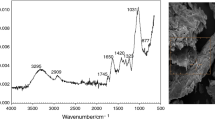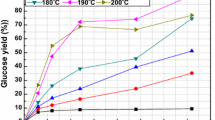Abstract
The effect of different treatments on the enzymatic hydrolysis of furfural residue (FR) was investigated in delignification and structural features. In this case, hot water, ethanol, sodium hydroxide, alkali ethanol, and alkaline hydrogen peroxide solution (AHP) were selected as the delignification solvents. The structure and morphology of the original and treated samples were comparatively studied by diffuse reflectance infrared Fourier transform spectrometry (DRIFT), XRD, SEM, and CP/MAS 13C NMR. After AHP treatment, the ratio of total lignin to cellulose content in FR and the absorbance ratio of lignin to cellulose (A 1508/A 1057) on the sample surface in the DRIFT spectra was reduced from 0.99 to 0.13 and from 0.40 to 0.04, respectively, which resulted in the highest conversion of cellulose to glucose (99.3 %). It was found that the crystallinity index of FR linearly increased with the decrease of total lignin to cellulose ratio. DRIFT analysis indicated that the high lignin content on the sample surface resulted in a low enzymatic hydrolysis efficiency.





Similar content being viewed by others
References
Sun YD, Sun R, Jiang JX, Zhu LW (2008) Study on conversion process of the residue of furfural manufacture to ethanol by simultaneous saccharification and fermentation. Mod Chem Ind 28:48–52
He X, Miao Y, Jiang X, Xu Z, Ouyang P (2010) Enhancing the enzymatic hydrolysis of corn stover by an integrated wet-milling and alkali pretreatment. Appl Biochem Biotech 160:2449–2457
Rinaldi R, Schüth F (2009) Acid hydrolysis of cellulose as the entry point into biorefinery schemes. ChemSusChem 2:1096–1107
Yang B, Wyman CE (2008) Pretreatment: the key to unlocking low-cost cellulosic ethanol. Biofuel Bioprod Bior 2:26–40
Silverstein RA, Chen Y, Sharma-Shivappa RR, Boyette MD, Osborne J (2007) A comparison of chemical pretreatment methods for improving saccharification of cotton stalks. Bioresour Technol 98:3000–3011
Yoon H, Wu Z, Lee Y (1995) Ammonia-recycled percolation process for pretreatment of biomass feedstock. Appl Biochem Biotech 51–52:5–19
Cara C, Ruiz E, Oliva JM, Sáez F, Castro E (2008) Conversion of olive tree biomass into fermentable sugars by dilute acid pretreatment and enzymatic saccharification. Bioresour Technol 99:1869–1876
Kim S, Um B, Park S (2001) Effect of pretreatment reagent and hydrogen peroxide on enzymatic hydrolysis of oak in percolation process. Appl Biochem Biotech 91–93:81–94
Sluiter A, Hames B, Ruiz R, Scarlata C, Sluiter J, Templeton D, Crocker D (2011) Determination of structural carbohydrates and lignin in biomass. National Renewable Energy Laboratory (NREL) Laboratory Analytical Procedures (LAP) for standard biomass analysis. <http://www.nrel.gov/biomass/analytical_procedures.html>
Sannigrahi P, Kim DK, Jung S, Ragauskas K (2011) Pseudo-lignin and pretreatment chemistry. Energy Environ Sci 4:1306–1310
Segal L, Creely JJ, Martin AE, Conrad CM (1959) An empirical method for estimating the degree of crystallinity of native cellulose using the X-ray diffractometer. Text Res J 29:786–794
Hernandez M, Hernández-Coronado MJ, Pérez MI, Revilla E, Villar JC, Ball AS, Viikari L, Arias ME (2005) Biomechanical pulping of spruce wood chips with Streptomyces cyaneus CECT 3335 and handsheet characterization. Holzforschung 59:173–177
Kumar R, Mago G, Balan V, Wyman CE (2009) Physical and chemical characterizations of corn stover and poplar solids resulting from leading pretreatment technologies. Bioresour Technol 100:3948–3962
Zhu L, O'Dwyer JP, Chang VS, Granda CB, Holtzapple MT (2008) Structural features affecting biomass enzymatic digestibility. Bioresour Technol 99:3817–3828
Sun R, Song XL, Sun RC, Jiang JX (2011) Effect of lignin content on enzymatic hydrolysis of furfural residues. Bioresources 6:317–328
Mosier N, Wyman C, Dale B, Elander R, Lee Y, Holtzapple M, Ladisch M (2005) Features of promising technologies for pretreatment of lignocellulosic biomass. Bioresour Technol 96:673–686
Öhgren K, Bura R, Saddler J, Zacchi G (2007) Effect of hemicellulose and lignin removal on enzymatic hydrolysis of steam pretreated corn stover. Bioresour Technol 98:2503–2510
Yang B, Wyman CE (2004) Effect of xylan and lignin removal by batch and flowthrough pretreatment on the enzymatic digestibility of corn stover cellulose. Biotechnol Bioeng 86:88–98
Kumar R, Wyman CE (2009) Effects of cellulase and xylanase enzymes on the deconstruction of solids from pretreatment of poplar by leading technologies. Biotechnol Progr 25:302–314
Kadla JF, Hm C (2001) The reactions of peroxides with lignin and lignin model compounds. In: Argyropoulos DS (ed) Oxidative delignification chemistry. American Chemical Society, New York, pp 108–129
Li MY, Foster C, Kelkar S, Pu YG, Holmes D, Ragauskas A, Saffron CM, Hodge DB (2012) Structural characterization of alkaline hydrogen peroxide pretreated grasses exhibiting diverse lignin phenotypes. Biotechnol Biofuels 5:38
Gierer J (1997) Formation and involvement of superoxide (O2 · −/HO2·) and hydroxyl (OH·) radicals in TCF bleaching processes: a review. Holzforschung 51:34–46
Nakagame S, Chandra RP, Saddler JN (2011) The influence of lignin on the enzymatic hydrolysis of pretreated biomass substrates. In: Zhu JY, Zhang X, Pan XJ (eds) Sustainable production of fuels, chemicals, and fibers from forest biomass. American Chemical Society, Sweden, pp 145–167
Studera MH, DeMartini JD, Davis MF, Sykes RW, Davison B, Keller M, Tuskan GA, Wyman CE (2011) Lignin content in natural Populus variants affects sugar release. PANS 108:6300–6305
Ishizawa C, Jeoh T, Adney W, Himmel M, Johnson D, Davis M (2009) Can delignification decrease cellulose digestibility in acid pretreated corn stover? Cellulose 16:677–686
Sannigrahi P, Ragauskas AJ, Miller SJ (2008) Effects of two-stage dilute acid pretreatment on the structure and composition of lignin and cellulose in loblolly pine. Bioenerg Res 1:205–214
Park S, Baker JO, Himmel ME, Parilla PA, Johnson DK (2010) Cellulose crystallinity index: measurement techniques and their impact on interpreting cellulose performance. Biotechnol Biofuels 3:10
Wikberg H, Maunu SL (2004) Characterisation of thermally modified hard- and softwoods by 13C CPMAS NMR. Carbohydr Polym 58:461–466
Acknowledgments
The authors are extremely grateful for the financial support from the Fundamental Research Funds for the Central Universities (BLYJ201315), National Natural Science Foundation of China (31110103902), Major State Basic Research Projects of China (973-2010CB732204, 2012CB215302), the Ministry of Science and Technology (2012 BAD32B06), and State Forestry Administration (201204803).
Author information
Authors and Affiliations
Corresponding authors
Rights and permissions
About this article
Cite this article
Sun, SN., Cao, XF., Li, MF. et al. Treatment of Furfural Residue by Solvent Extraction for Enzymatic Hydrolysis: Effect of Delignification on the Structure and Digestibility. Bioenerg. Res. 6, 1022–1029 (2013). https://doi.org/10.1007/s12155-013-9329-0
Published:
Issue Date:
DOI: https://doi.org/10.1007/s12155-013-9329-0




